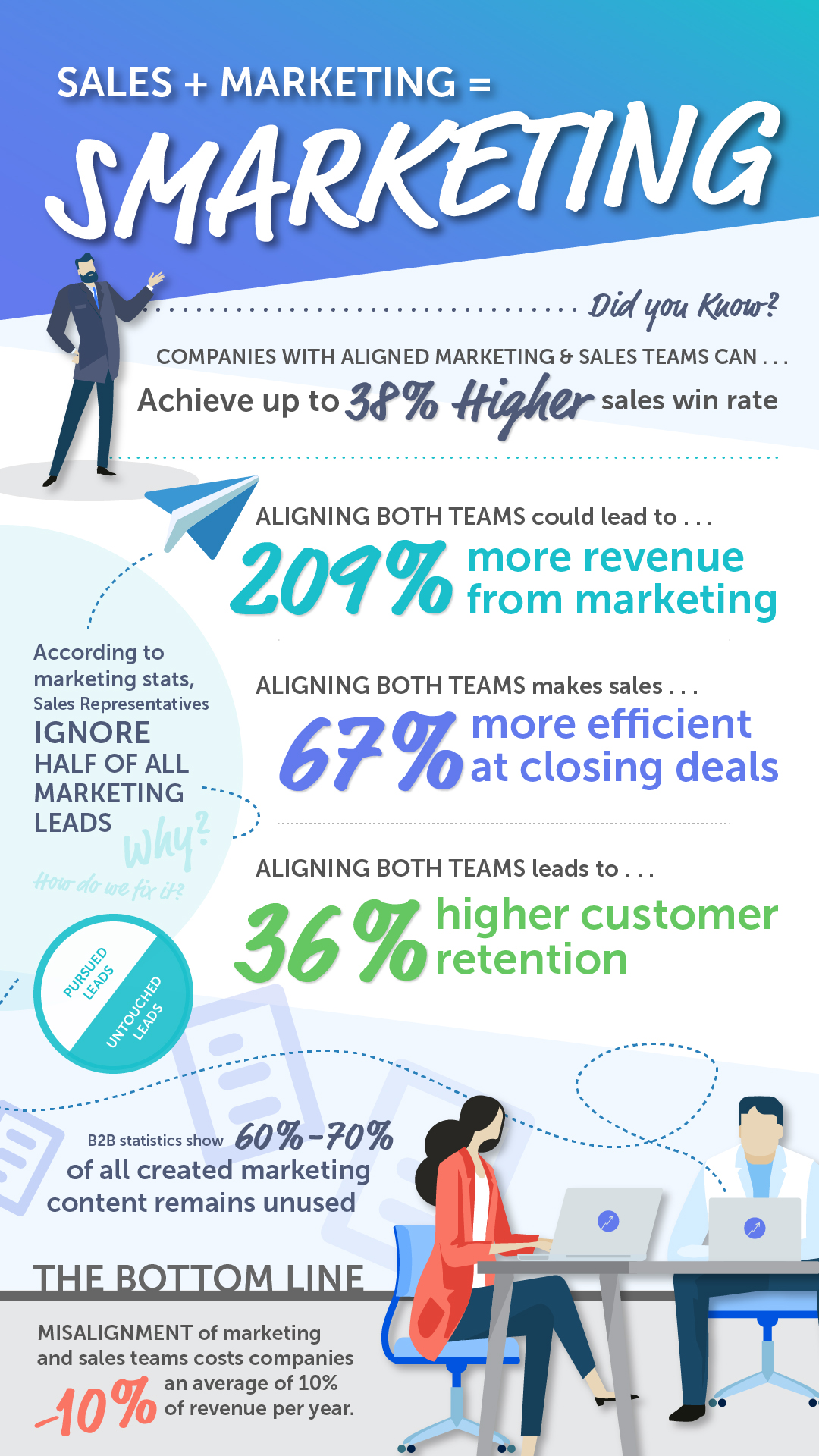Contact-based tactics are no longer effective in the B2B industry. Instead, traditional contact-based selling is converting into modern-day account-based selling. You might consider account-based sales as a new concept, but businesses are rapidly making it the standard for sales.
In this article, we will quickly run you through what is account-based selling, why it works for B2B companies, and what you should do to implement a successful account-based sales strategy.
What is Account-Based Selling?
Account-based sales is a sales technique that focuses on businesses (or accounts) rather than individual leads and considers them a market of one. It is a targeted strategy to B2B sales that entails allocating resources to key stakeholders within an account.
Executing a successful account-based sales strategy means speaking to the stakeholder’s pain areas and specific interests. This enables you to convert potential accounts into customers. Similar to account-based marketing, the foundation of account-based sales strategy is personalization which makes it a successful approach in closing B2B sales.
What is Account Based Sales
Account-Based Sales (ABS) aligns sales and marketing to target high-value accounts with personalized outreach and tailored solutions. It focuses on building strong relationships, increasing conversion rates, driving revenue growth, and enhancing customer satisfaction through customized strategies. ABS stands out for its precision in addressing individual account needs and delivering value-driven proposals.
Why Does Account-Based Selling Work for B2B Companies?
Account-based selling started as a buzzword in the B2B industry but has become vital for sales strategy.
Cold outreach has taken a back seat, and personalization is driving the sales for the B2B industry. If you want to be successful in selling, you need to put yourself in your buyer’s shoes. However, you will not fit in every buyers’ shoes and vice-a-versa. If you have identified the best fit for your product or solution, you need to personalize the sales experience from prospecting to being your paying customer. That’s what account-based selling does for you.
5 Steps to Account-Based Selling Success
Following are the five steps to consider if you plan to implement an account-based selling strategy for your business.
1) Prioritize Sales and Marketing Alignment
Coordination between the sales and marketing team is the heart and soul of account-based selling. If sales and marketing teams are not on the same page, you may see a gap in the messaging by both departments.
An account-based selling approach brings better sales and marketing alignment and the benefits described in the infographic below.

Here are a few quick tips to ensure your two most crucial head departments of your business are on the same page:
- Plan: You can create a process for the departments to be fully aware and focused on a successfully tested marketing and sales funnel.
- Define: Clearly define your marketing qualified lead (MQL) and sales qualified lead (SQL) criteria. Give the respective departments accountability for the MQL and SQL.
- Analyze: Analyze the lead flow and conversion rate. Identify the sources from where you are getting a majority of your customers.
- Connect: Let the two departments meet at least once a quarter (ideally more often) to strengthen their bond with each other.
2) Build Your Ideal Customer Profile
You should build your ideal customer profile (ICP). This has to be unique as replicating anybody else’s framework or the ICP won’t work. Top management must extensively research and identify its customers before defining the best account qualities.
When it comes to account-based selling, departments should already be collaborating. Your ICP must get feedback from a range of sources. The ICP as defined by a salesperson may differ from that of a marketer or an account executive.
You can create a standardized ICP considering a few questions and data. This will help you create an overall personalized approach from content creation to sales outreach.
Developing your ideal customer profile based on data is the best way to do it. Use a powerful combination of existing customer insights, firmographic, technographic, and behavioral data points to create one for your business.
You can consider the following crucial questions you need to consider:
- What encouraged your top customers to buy from you, and what triggers motivated them to buy?
- Where and how do your customers like to engage, or what are channels they actively use?
- What type of marketing and sales messaging resonates with your top paying customers?
Once you have all of this information, your team can target with more efficiency and accuracy.
3) Identify Your Target Accounts
Once you have a strong ICP ready with you, it’s time to find the best-fit accounts to target.
To begin, you must define the kind of accounts you intend to target, the users you intend to interact with within those accounts, and the various forms of content you intend to utilize to engage them. Once you’ve determined your target audience, you may establish a user list. ABS experts recommend creating a target account list for each degree of required sales attention.
Your team can spend different amounts of energy, customization, and focus on each, with the smallest, highest-value level receiving the most and the largest, low-value level receiving the least.
You can consider 20-50 accounts for the first-level targeting. These accounts should be high-ticket size accounts. At this step, the accounts receive in-depth analysis and one-on-one tailored outreach.
The second level should have around 200 accounts. These are potential accounts but with a probably low to moderate ticket size. Sales reps can communicate with them by phone, email, and social media, while the marketing team uses ads and events.
Another smart way to identify target accounts is by analyzing your website visitors. You can do this by using a visitor identification tool. VisitorIntel, for instance, is an analytics-driven feature of SalesIntel that reveals which companies are visiting your website and allows connecting with the buyer directly early in the sales funnel.
4) Align the ABS to the Customer Journey
Although they can have varying needs, each stakeholder in a company normally goes through the same stages of a buyer’s journey. Depending on the system you use, this journey usually entails knowledge, curiosity, concern, purchasing, and activism stages.
For example, the interest of the Chief Financial Officer (CFO) may be caught by a message that illustrates the impact of a product on lowering operating costs.
Meanwhile, a message that introduces a product as a competitive advantage within a niche could push the CEO to engage.
Your sales team needs to track the conversation with each stakeholder and guide them to all being on the same page for buying.
5) Create and Map Your Content Strategy
Content often falls into the marketing department. However, as a sales representative, you understand your customers in and out. You can communicate what type of content formats your leads or customers like to consume. You can also ask marketing for content that will help you in engaging the lead and closing sales.
Salespeople and marketers frequently go broad, attempting to reach as many people as possible with as many pieces of content as possible in the quickest amount of time. This haphazard approach inevitably wastes resources, materials, and time. That is not high-value work. High-value content is content that is relevant to your target audience.
You need to identify particular targets and approach them with customized content. Knowing your accounts and their stakeholders closely are required for really tailored content.
Take your general content and let sales tweak it for the account or even individual stakeholders.
Start Implementing Account-Based Selling Approach
As you can see, account-based sales are no easy task. It is a strategy that necessitates extensive planning and coordination throughout the company. But don’t get too worked up. No one embarks on a new plan without encountering a few roadblocks and getting a little help.
Account-based sales can be used if you have good alignment, awareness, and data availability. When you begin seeing results, you’ll wonder why you didn’t make the change sooner. Our complete B2B data intelligence platform is the tool you need to get started and fulfill your sales goals.





